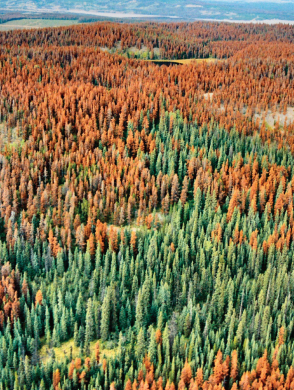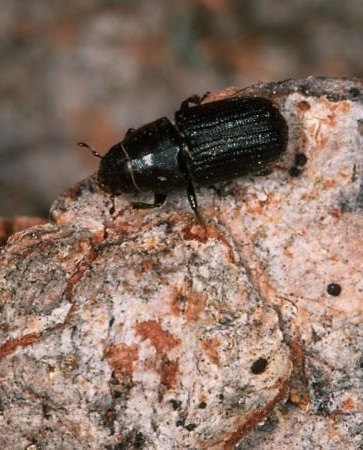Mountain pine beetle
Dendroctonus ponderosae
The mountain pine beetle is a naturally occurring insect in the Rocky Mountain ecosystem. In the late 1990s, after several relatively warm winters, a massive outbreak resulted in the loss of millions of hectares of pine forest in British Columbia over the next 15 years.
On this page
Description
This small beetle attacks and kills mature trees by boring through the bark and mining the phloem (living tissue in vascular plants that carries organic nutrients). The eggs hatch into larvae that consume the phloem, killing the tree.
Adult mountain pine beetles are brown to black in colour and tiny (5mm to 7mm long). The life cycle is one year, although colder climates can require two, and one brood is produced.
The beetles are killed by very cold winter weather, which historically has kept their numbers in check.
The B.C. government took a range of measures to respond to the 1999 - 2015 outbreak's effects on forests, communities and industry.
Host tree species
Large-diameter, mature, and over-mature lodgepole pine are by far the most commonly affected tree species. Western white, whitebark, and ponderosa pine may also be attacked.
Mountain pine beetles prefer to attack larger, mature trees that are more than 80 years old.
Native to North America, this insect is found throughout the range of its hosts (pine trees).
Damage symptoms
Damage symptoms include reddish boring dust at the base of attacked trees and bark removal by woodpeckers, which can target larvae in attacked trees.
Trees will attempt to repel the beetles by releasing quantities of resin, which mixes with the boring dust and forms a soft, white or reddish pitch tube around each bore hole. These pitch tubes usually appear from the duff line to a top diameter of 15cm.
Tree foliage turns yellow and then red by the spring of the year following the initial beetle attack. Most of the needles drop from the tree after two years, leaving a dead grey snag.
Identification images
Large area of mountain pine beetle damaged forest

An adult mountain pine beetle

Further reading
For more information on identifying mountain pine beetle damage, refer to the Field Guide to Forest Damage in B.C. (PDF, 6.5MB).
Contact information
Contact us if you have further questions about Forest Health in B.C.
